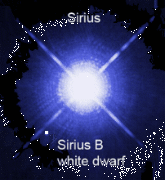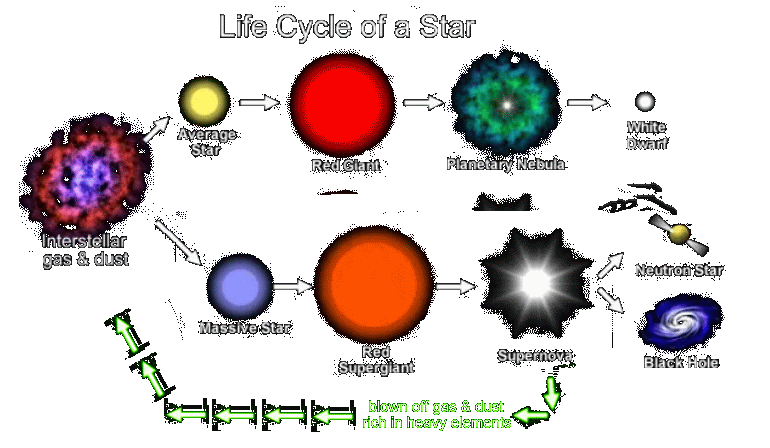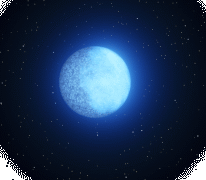  White dwarfs are the remains of medium-sized stars similar to our Sun. Once these stars have burnt all the nuclear fuel in their core, they shed their outer layers, leaving behind a hot core that starts cooling down. It is estimated that up to 97% of stars in our Milky Way Galaxy will eventually turn into white dwarfs, while the most massive of stars will end up as neutron stars or black holes.
White dwarfs are the remains of medium-sized stars similar to our Sun. Once these stars have burnt all the nuclear fuel in their core, they shed their outer layers, leaving behind a hot core that starts cooling down. It is estimated that up to 97% of stars in our Milky Way Galaxy will eventually turn into white dwarfs, while the most massive of stars will end up as neutron stars or black holes.During its life, a star burns through its hydrogen reserves, steadily converting that element to helium through a process known as nuclear fusion. Helium is heavier than hydrogen; as it accumulates, the core contracts and grows hot enough to burn helium into carbon. Carbon combines with helium to make oxygen. As the star continues hydrogen and helium burning, it balloons up into a red giant star, but soon starts to run out of nuclear fuel in its core; the star lacks the mass and the accompanying heat and pressure to burn the heavier elements, so burning halts at oxygen. This causes the outward radiation pressure to decrease, allowing the outer layers to collapse due to gravitational forces onto the hot core, which results in an explosion which blows off the outer layers. The core is crushed into a planet-sized sphere of densely packed carbon and oxygen with a temperature of over 100,000° C . A white dwarf is created. The cooling of a white dwarf lasts billions of years. Once it reaches a certain temperature, the originally hot matter inside the star's core starts crystallizing, becoming solid. The process is similar to liquid water turning into ice on Earth at zero degrees Celsius, except that the temperature at which this solidification happens in a white dwarf is extremely high, about 10 million degrees Celsius. [The star might continue to crush itself into an even smaller object, but electrons in the carbon and oxygen atoms move to higher orbits and pick up speed during the contraction, resisting a potential implosion. It's called electron degeneracy pressure, and white dwarfs are said to be made of degenerate matter]. Tthe star's blown off outer layers often glow in the ultraviolet light emitted by the dwarf, creating a coloruful planetary nebula, which expands and fades from view over a period of up to 50,000 years, leaving only a tiny, white-hot glowing ember that steadily grows cooler until it fades to become a black dwarf. This will almost certainly be the fate of our Sun some 6 billion years from now. It takes something like a trillion years for a white dwarf to go black; our universe is too young for any to have been created yet. 
A familiar and, at a distance of just 8.6 light-years, relatively nearby white dwarf star is Sirius B, the companion to Sirius, which is the brightest star in our night sky. The Earth-sized white dwarf Sirius B is extremely massive; it matches the Sun's mass, while being the size of Earth. A spoonful of matter taken from a white dwarf would weigh 5 tonnes. This is the way stars like our Sun die, unless they happen to be part of a binary star system that could give rise to a supernova explosion. Type Ia supernovae result from pairs of white dwarfs spiralling inwards and merging together. When a star like the Sun is in old age it becomes a red giant as it burns helium fuel and deposits carbon and oxygen in its core. The Sun does not have sufficient mass for its core to ever become hot enough to burn carbon into heavier elements such as neon and magnesium. When a star burns fuel it is fusing the nuclei of the atoms of an element together to make a heavier element, such as fusing hydrogen into helium, or helium into carbon, or oxygen and nitrogen, etc. The exact mass limit below which a star can become a white dwarf is not known exactly, because it varies according to how much mass a star loses late in its life. The mass of the remaining star core must be below a maximum limit, called the Chandrasekhar limit, and is about 1.44 solar masses. If the core remnant has more mass than the Chandraekhar limit then it will condense into either a neutron star or a black hole.  All elements heavier than iron were once thought to have been created in the explosion of supernovae, following which these elements were scattered in the gas and dust remnants fom the explosion, to eventually condense once again into stars and planetary systems. [shown above] New research, however, suggeats that these heavier elements may have been formed following the collision of neutron stars in binary systems.  In a white dwarf, the matter compresses to an enormous density. It is very hot, as it was once the active core of a star, but is
now exposed to outer space and will slowly cool over billions of years, as it no longer burns fuel by nuclear
fusion to generate heat.
In a white dwarf, the matter compresses to an enormous density. It is very hot, as it was once the active core of a star, but is
now exposed to outer space and will slowly cool over billions of years, as it no longer burns fuel by nuclear
fusion to generate heat. The inside the white dwarf is like a very dense gas, with electrons ripped from the nuclei and nuclei vibrating due to their thermal energy. The thermal energy of the ions initially prevents further contraction of the star, but as the white dwarf cools it crsytallises and now resembles very hot and very dense solid metal. When this happens, the white dwarf will contract slightly, until the electrons are squeezed together as tightly as quantum mechanics will allow. The degeneracy pressure produced by these tightly packed electrons stops the core from collapsing under its own gravity. Interestingly, the dense crystallised core of a carbon rich white dwarf has been likened to a huge diamond the size of the Earth, since diamond is crystalline carbon! Eventually, as described above, the white dwarf cools and dims, turning yellow, orange, red and finally ending as a cool black dwarf. This dead remnant is the ultimate fate of the Sun. |